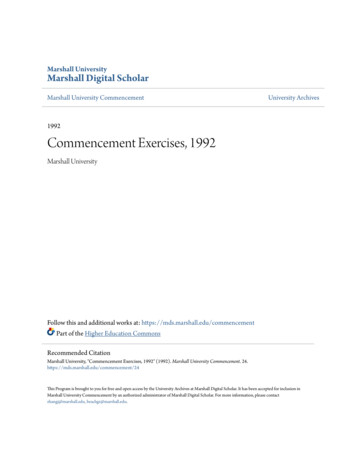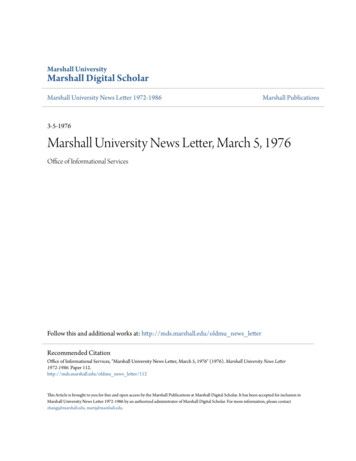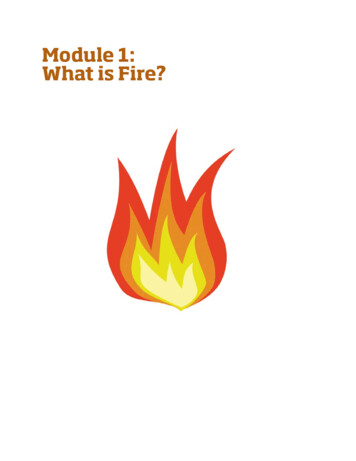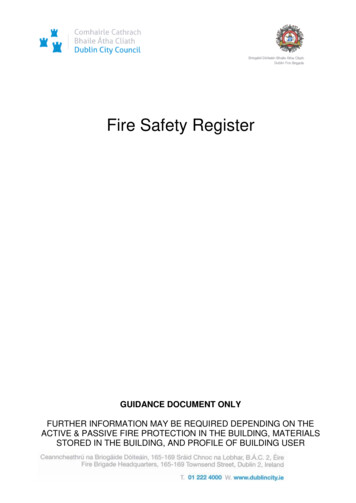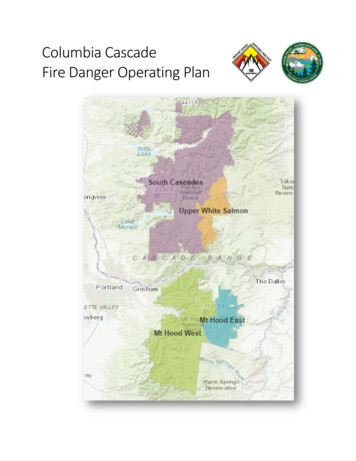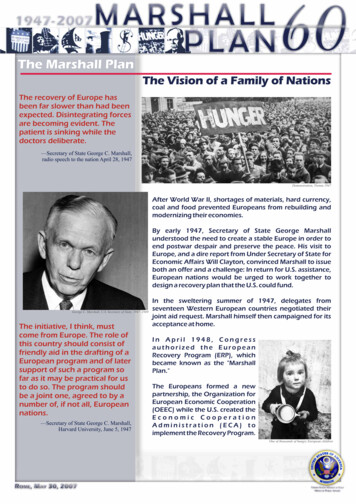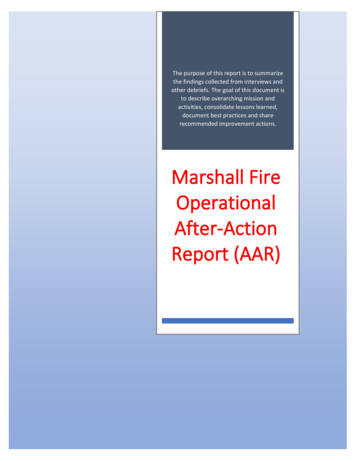
Transcription
The purpose of this report is to summarizethe findings collected from interviews andother debriefs. The goal of this document isto describe overarching mission andactivities, consolidate lessons learned,document best practices and sharerecommended improvement actions.Marshall FireOperationalAfter-ActionReport (AAR)0
Marshall Fire Operational AARDecember 30, 2022ContentsSummary. 2Introduction . 3Summary of the weather conditions for the Marshall Fire on December 30, 2021. . 3Prior to the Marshall Fire . 3The Marshall Fire Begins . 4Summary of Events of the Operational Response . 5What Worked Well. 6Marshall Fire Evacuations Zones. 10Fire Response AAR Improvement Plan . 11Law Response AAR Improvement Plan . 12AAR Improvement Plan Alert & Warning. 14AAR Improvement Plan Sheriff 911 Communications Center . 17Louisville Fire and Police . 19Significant Events Fire . 19Significant Events Police . 20What Worked Well . 21AAR Improvement Plan City of Louisville . 23Type 1 Incident Management Team . 29Significant Events: . 29Notable Successes:. 30Challenges and Resolutions: . 30Boulder EOC AAR for Marshall Fire . 33AAR Improvement Plan EOC . 45AAR Improvement Plan ESF 21 Animal Management . 47AAR Improvement Plan BCARES . 50Recommendations for Building Capacity and Improvements in the Future . 54Conclusion . 54After Action Report Methodology . 541
SummaryThe After-Action Review (AAR) process is useful for reflecting upon an incident after itscompletion, fostering organizational learning, identifying areas of improvement, and learningfrom successes, challenges and failures. The ultimate goal of the AAR process is to improveresponse to future disasters.Conducting the AAR process takes into consideration the complexity of the incident or disaster,and the duration and size of the operational response to design an effective process. TheMarshall Fire AAR effort brought together decision makers and tactical resources into targetedAAR discussions to obtain critical elements of information, establish timelines, recountexperiences based on areas of effort and extract what went well and what gaps or needs werepresent. The AAR process focuses on the operational response to the Marshall Fire for the first12-36 hours.The AAR begins with an introduction describing the weather conditions and the operationalenvironment that existed at the time of the Marshall Fire. The additional sections provide atimeline of events when possible, highlighting a summary of significant events based upon theinput of individuals involved, defining what went well, identifying what did not go well andintegrating recommendations into an improvement plan. The improvement plan addresseschallenges that were faced or actions that did not go well. The gaps identified can be addressedthrough planning efforts, applying organizational capacity, dedicating resources, providingequipment, staffing, training and developing exercises to test and evaluate effectiveness ofimprovements made.The improvement plan design identifies the capability area, observations from participantsabout what did not go well, and corrective action recommendations, and it identifies the leadagency, the name of the responsible person to lead the corrective action and a time forcompletion. The lead agency and person are responsible for facilitating or leading the correctiveaction program or process. Most if not all corrective action programs and processes identifiedin this report require the involvement of multiple jurisdictions and the engagement of theirleadership, operational supervisors and personnel to be successful. Implementing theimprovement planning effort is the most important step in the AAR process for continuousimprovement to be successful in addressing gaps.The After-Action Review provides analysis for lessons learned, best practices andrecommendations for future planning, training, and exercise development. As improvementactions are identified and addressed, it is important that any relevant plans, policies andprocedures are updated accordingly.2
Marshall Fire Operational AARDecember 30, 2022IntroductionSummary of the weather conditions for the Marshall Fire on December 30, 2021.https://www.weather.gov/bou/HighWinds12 30 2021On Thursday, December 30, 2021, the devastating Marshall Fire roared through unincorporatedBoulder County, Superior and Louisville, Colorado. The fire started south of Boulder, Coloradoand was fanned by intense winds along the Front Range Foothills. Wind gusts from 70 to 100mph occurred right at the base of the foothills, including in Boulder and along Highway 93south toward Golden. The strong winds fanned a destructive grass fire which originated nearMarshall in unincorporated Boulder County, and then quickly spread east to Superior andLouisville. At last count, the Marshall Fire destroyed 1,084 homes, and seven commercialstructures and damaged 149 homes and 30 commercial structures.The very strong winds developed in the mid-morning hours on Thursday as the result of amountain wave that developed from very strong westerly winds racing over the Front RangeMountains and Foothills. The mountain wave remained nearly unchanged through the rest ofthe day, resulting in very persistent and extremely high winds that was focused very close tothe base of the foothills, along Highway 93 and points east to around Superior and, Louisville. Ittakes just the right combination of meteorological parameters, including stability, wind shear,and wind magnitude, to create a powerful and damaging windstorm like this one.The second component that contributed to this disaster was the lack of precipitation during thelatter half of 2021. The Front Range experienced a very wet first half of the year with muchgreater than normal precipitation and lush and tall grass growth. However, starting aroundJuly, a persistently dry weather pattern set up and held firm through the entire fall and earlywinter. Grasses, while typically dry this time of year, were exceptionally dry as very little snowhad occurred through the entire fall season. The temperature and precipitation from July 1through December 29 ranks as the 2nd warmest and by far the driest in the Denver’s recordedhistory (since 1872). This same time period for Boulder was ranked 2nd warmest forprecipitation, while 13th driest in recorded history.Prior to the Marshall FireAt 10:15 a.m. the Lefthand Fire Protection District responded to the Middle Fork fire north ofBoulder, and the weather conditions and high winds caused rapid growth of that fire. TheMiddle Fork fire attracted multiple fire departments from Allenspark, Hygiene, Lyons, BoulderMountain Fire Protection District, and Boulder County Sheriff Fire Management Team toprovide fire suppression and 15 Sheriff’s Office Deputies to evacuate residents in the area. Firstresponders reported fire spreading quickly with high winds as they started to engage in fightingthe fire and initiating evacuations. The Boulder Incident Management Team (IMT3) wasrequested and responded to the scene. The 911 center was receiving hundreds of callsreporting the fire and launching emergency notifications through the Everbridge system toresidents. An evacuation site was established in Longmont at the Memorial Building for3
Marshall Fire Operational AARDecember 30, 2022evacuees of the fire. The Boulder Emergency Operations Center was not activated, but two staffmembers were supporting the IMT3 call out process and evacuation site efforts.The City of Boulder Fire Department also was fighting wildfires during this time and into theafternoon along their western flank of the city.The Marshall Fire BeginsAt 11:05 a.m. the Boulder County Sheriff’s 911 Center dispatched Mountain View FireProtection District and Sheriff’s Office Deputies to a line down near Marshall Road and EldoradoSprings Road. A fire had developed near that same area, and it spread rapidly in cured grassfuels (dry grass materials) with relative humidity around 20% and winds up to 100 mph. Thefire, now known as the Marshall Fire, began consuming structures almost immediately.Resources were directed from the Middle Fork Fire at 11:15 a.m. due to the Marshall Firestarting. Fire crews discovered a shed on fire in the area and begin to attack the fire. The firewas spreading in other areas, but the spread initially was not detected because the wind wascausing a tremendous amount of smoke, dirt, dust, and debris that concealed the fire’s growthand direction. Once crews determined that the fire was spreading east, the fire attackbroadened. Law enforcement began to call for evacuations immediately and started the doorto-door evacuation process. At 11:30 a.m. the Emergency Operations Center started to open,and notifications were made to Emergency Support Functions to activate for the Marshall Fire.Evacuations were being done by deputies and fire firefighters in the area of Marshall Road, 76thStreet, and Cherryvale Road. The 911 center saw a large increase in calls to report the fire andin calls for assistance. As the fire progressed towards the town of Superior and the largecommercial area around Costco and Target, it was evident that the fire was going tosignificantly impact Superior and appeared likely to directly impact the city of Louisville. At 2:30p.m., evacuation of Avista Hospital began. Evacuations continued, and coordination betweenthe IMT3 and the Boulder County Law Branch was critical for successful evacuation of residents.As the evening continued, the devastation further extended into the town of Superior and thecity of Louisville.There were two fatalities during the Marshall Fire, one in the Marshall area and the other in thetown of Superior. Both fatalities had been contacted by law enforcement during the evacuationprocess and advised to leave.At approximately 6:30 p.m., the wind decreased to 25-30 mph and the fire behavior decreasedin intensity and rate of spread. High winds continued into the evening, and by the morning ofDecember 31 fire size was estimated at 6,000 acres.The morning of December 31 brought a significant weather change: winds were less than 10mph and snow was forecast for later in the day. The afternoon brought four to eight inches ofsnow which effectively stopped all forward spread of the wildland fire.4
Marshall Fire Operational AARDecember 30, 2022Summary of Events of the Operational Response1024: Middle Fork starts and is drawing in fire resources and 15 deputies. Fire spreadingquickly with high winds reported.1105: Marshall Fire call is dispatched.1123 Fire Command requests additional units to Marshall Fire. Fire moving east through propertyto homes.1138: Evacuations start in Old Marshall and along Cherryvale north.1150: Cherryvale Law Units begin evacuating South Vale and Wildflower Ranch.1159: Fire begins running east down Marshall Rd. Middle Fork Incident Command calling forresources.1200: BCSO fire command and law command tie in together and operational coordinationestablished. Relocated ICP to 76th Street and Marshall Road.1203: Fire is reported past water treatment plant moving at rapid rate toward Superior.1206: Start evacuations for S 76th Sagamore, and Costco area. Flames reported at the back ofSagamore subdivision.1215: Evacuation Orders issued through Everbridge system to unincorporated Boulder Countyand Superior and went to McCaslin. Door to door evacuations initiated for the next 30minutes in the area.1218: Costco evacuating, and fire is at Mohawk. Fire in parking lot of Costco and smokeobscuring everything.1219: Flames have reached Sagamore.1235: Mountain View Fire Department calls for Spanish Hills evacuations. Fire is there beforeevacuations.1241: 911 Center started airing home addresses and was overwhelmed with reports.1245: Fire reported behind Home Depot in Louisville.1246: At 68th and South Boulder reports of fire in the area.1250: Call for evacuations south of South Boulder Road also SCL Hospital evacuation, andMcCaslin East to Sports Stable needs to evacuate.1250: Decision is made to evacuate the entire town of Superior.5
Marshall Fire Operational AARDecember 30, 20221256: Flatirons Mall contacted, and work started on getting access to use Nordstroms(closed/moved out) to take shelter from wind and set up ICP while waiting for MobileCommand Post.1300: Law Division is established at Flatirons Mall. Teams are designated from arriving outsideagencies for full Superior evacuation.Teams of 10 are assigned radio designators of A-P and assigned to one of three tasks;Evacuations (overall evacuations of large areas), Critical or Tactical Evacuations (peopleneeding help or in areas that had already been evacuated), and Road Closures/ Trafficcontrol (including areas in Louisville).1308 Louisville running operations and door to door evacuations.1315: Mobile command post at the Flatirons Mall and the Law Branch was establishedboosting incident command from IMT3.1402: Teams assigned to flush traffic eastbound only, at US36/ McCaslin and Rock CreekPkwy/Coalton. Mountain View Fire assigned to help with evacuations at Urgent Careand then Avista.1500: IMT provided planning, resource status, situation status, logistics, check in with divisionsand branches, coordination with evacuation planning.1520: Delegation of management of the fire to the Sheriff.1530 Entire town of Superior Evacuated.1537 Boulder Police SWAT Team assigned to assist Louisville with evacuations and beganevacuating Zones 1, 2,3,4 and set their own staging at Monarch High.1540: Delegated the fire to IMT3 as the Incident Commander.1600: Delegated the fire to the state, evacuations and firefighting continuing.1900: Wind shifting and making progress and the system started to catch up to the incident.South Metro Fire, North Metro Fire, Jefferson County Communication, State EmergencyOperations Center and CO Division of Fire Prevention and Control all ordering resources.2000 to 0700: The weather conditions are notably changed from the prior 9 hours. Fire crewscontinue to fight fires through the night. Evacuations continue door to door by lawenforcement. Site access control planning begins to control access. BIMT continues tomanage the incident and orders resources for the next day and completes incidentaction planning.What Worked WellInteragency Cooperation.6
Marshall Fire Operational AAR December 30, 2022Instructions and assignments were clear, and personnel knew exactly what was supposed tobe done and were able to stay on the tasks at hand.Communications between multiple law agencies was effective because law enforcementhad clear and concise information. Agencies used Law channel and cell phones forcommunication.Relationships with other agencies worked well. Pre-existing relationships, either fromworking on prior incidents together or through previous interactions, were great and key tooperational successes.During extreme conditions and hardships not encountered on other incidents thecommitment to work well together from all agencies was experienced throughout theoperation.Incident Command Establishing unified command by law enforcement with fire departments early on in bothincidents increased effectiveness in making operational decisions and use of resources.Utility company presence and the development of a strong interface with the incidentcommand post was effective in controlling utilities in the area, making it safe for firstresponders.IMT3 deployment and assumption of command added capacity to manage the complexityand escalation of the incident until the FEMA IMT1 team took the fire on January 1, 2022Operational & Resource Management Assembling resources quickly and handing out assignments (from Longmont Police SWATand Boulder Police SWAT) was critical to the effective door to door evacuations.Radio discipline within the law enforcement groups was excellent and preventedoverloading operational channels preventing radio network failures. Personnel saved radiotraffic for important information.There was great initiative. Numerous people saw a problem and took it upon themselves torectify the situation as opposed to having to be ordered to. The ability to make decisionsand resolve issues at the point of the problem created many operational successes andresolved significant challenges encountered throughout the incident.Diverting law and fire resources quickly from the Middle Fork Fire to the Marshall Fireassisted with bolstering the response to the Marshall Fire as resources were becomingscarce awaiting additional resources to arrive.The loss of life in any disaster is hard to accept, and tragically two people did lose their lives.Due to the speed of the fire spreading into multiple communities simultaneously thepotential for many fatalities was present and fortunately did not manifest during thisincident.Over 1,100 homes and businesses were lost in this fire, but thousands of homes were savedbecause of firefighting efforts.7
Marshall Fire Operational AARDecember 30, 2022Evacuations The initial alerts and warnings for the Middle Fork Fire and the Marshall Fire went outquickly and roadblocks were established immediately.Door to door evacuations needed to be executed immediately into the response and quicklythroughout the Marshall Road 76th Street area. This included many residents and animals.Over 300 law enforcement resources assembled to perform door to door evacuations inSuperior, Louisville, and unincorporated areas of Boulder County.The fire spread was so aggressive that in three locations it jumped Highway 36, which is asix-lane divided highway. The fire caused a traffic jam requiring all traffic to be re-routed bylaw enforcement.Traffic congestion was resolved at Coalton/Rock Creek by sending everyone east fromCoalton in all lanes to Highway 36. This cleared out traffic jams in Rock Creek.Avista Hospital had to be evacuated in a short period of time due to the rapidly advancingfire. Through coordination of multiple agencies, evacuations were able to remove patientsto other facilities. There was a phone call directly from an Avista Nurse (inquiring aboutevacuating the hospital). Having direct contact with employee from the facility providedreal-time situational awareness for understanding the fire nearby. Due to informationprovided, the dispatcher advised to evacuate if in danger—same message provided to manycallers.Multiple long-term care facilities also had to be evacuated at the same time. Residents weremoved to other facilities due to effective facility emergency planning and transportationresources provided by ESF 1 Transportation.Additional dispatch staff brought into backfill, then identified a single dispatcher to manageevacuations and Everbridge.The Flatirons Crossing Mall provided a staging area large enough to support over 300 lawenforcement personnel, 74 fire agencies and hundreds of fire personnel. This permitted anefficient incident base and operating space for the incident management teams operatingthe incident command post.The fire was moving faster than some of the evacuation orders could be developed andlaunched. Social media use by the community and messaging between the Town of Superiorand City of Louisville assisted to provide messaging on social media about the fire.Communications to fire command was excellent between the 911 center to obtaininformation and relay critical updates.The evacuation of 37,500 people during a fast moving and multi-directional spreading fire ina relatively short period of time (3-4 hours) is unprecedented.Communications/ 911 CenterThe Sheriff’s Communication Center provides dispatching services for all law enforcementagencies in Boulder County except the City of Boulder, University of Colorado, and the City of8
Marshall Fire Operational AARDecember 30, 2022Longmont. In addition, the center also provides 911 dispatching and alert and warning servicesfor fire agencies and rescue agencies in Boulder County. The 911 services and dispatchingservices for the Middle Fork Fire and Marshall Fire were managed through this center. TheMiddle Fork Fire already had supervisors of the communications center starting to arrange foradditional staff due to the size and hazardous nature of the fire.The additional staffing was present or was already enroute, due to the dispatch all-page sentfor assistance during the Middle Fork Fire. Having these additional dispatchers added capacityby adding multiple fire dispatchers and one supervisor working the incident facilitated splittingroles and responsibilities. Back-up staff to assist with Computer Aided Dispatch for Fire and Lawchannels were also made available.There was strong room awareness by dispatchers, considering we were working in a temporarylocation with less than half the space and different layout and consoles available. Incomingadditional dispatchers knew where to go and who to back up. Additional supervisors were alsoavailable to make decisions and assist with dispatching, making concise and appropriateinstructions to callers, specific to each situation.9
Marshall Fire Evacuations Zones10
Fire Response AAR Improvement eManagementObservationCorrective ActionRecommendationsAgency administratorswere unfamiliar with thedelegation process.Incident managementteam (IMT) IncidentCommanders did notfully understand themultiple authorities andhow to negotiate therelationship at times.Need to optimizecommunicationsbetween incidentcommand and dispatch.County dispatch –resources, contactinformationAgencyadministrationmeeting and trainingOperationalCoordinationFire duty officer / Localresource coordinator(LRC)PlanningStructure AnnualOperating Plan (AOP)modelPrimaryResponsibleAgencyBoulder Mike gust2022Facilitate operationaldiscussion betweenIncident Commandand DispatchVerify all resourcesare properly listed inthe dispatch centersand appropriatecontact informationis present.Determine how tobest staff thisposition anddetermine duties.Fire ConsortiumOperationsCommitteeBoulder County Fire Chiefs(BCFC) Representatives andSteve SilbermannTBDTBDFire ConsortiumOperationsCommitteeBradshaw, Higgins, Beebe,BRETSAMay2022In ProgressFire ConsortiumOperationsCommitteeMay2022In ProgressDevelop a structuralmodel for responsein the AOP for firesthat start in wildlandFire ConsortiumOperationsCommitteeBCFC Representatives to bedetermined.Office of DisasterManagement ResourceManagement Section ChiefSeth McKinney and BrianOliverTBDTBD11
Marshall Fire Operational AARInteroperabilityDecember 30, 2022Local 8oo MHzcommunications plan-/grasslands andmove into urbanstructureenvironmentNeed to develop aVHf and 800 MHzcommunicationsplan.Radio /Scott WhiteheadCommunicationsTeamApril 2022Law Response AAR Improvement ons/800 communicationsplanRescue Task Forcemodel forevacuationsDevelop 800 MHzCommunications PlanBuild Rescue Task Forcemodel – a dedicated groupthat contains lawenforcement, fire, and EMSthat can be tasked as agroup to handleprojects/issues within theincident.Consolidation ofIncident Command/Operations DirectorsearlierEvaluate standardoperating procedures(SOPs) and adjust supportunified command orenhance commandcoordination earlier.OperationsIncident CommandCorrective il 12,2022April 2022BCSOBonafede/WilberApril 12,2022In ProgressBCSOChamberlin /WilberApril 12,2022In Progress12
Marshall Fire Operational AAREvacuationsControlling andmaintainingintersections/ trafficflowDecember 30, 2022Ensure current evacuationpolicies and SOPs considerevacuation traffic patternsand cover traffic controlobjectives.BCSOHeathmanApril 12,2022In Progress13
Marshall Fire Operational AARDecember 30, 2022AAR Improvement Plan Alert & WarningCapabilityObservationCorrective ActionRecommendationsEmergencyEvacuationOrders UsingIPAWSEvacuation orders or incidentsinvolving imminent orimmediate risk to life safetyneed to be managed by the 911centers.MultijurisdictionaldecisionmakingDuring a fast-moving incidenthaving pre-establisheddecision-making agreementswill help with alert and warningchallenges during response.EmergencyNotificationDatabaseDevelop a databasemanagement policy or processwithin the Boulder RegionalEmergency Telephone ServiceAuthority (BRETSA) structurePolygonsCounty Wide911Polygons exist west of HWY 36and need to be expanded toother communities in theCounty East of Hwy 36 / 93.Wireless emergencyalerts (WEA) /IPAWSintegrated into 911centers for use inimmediate life safetysituations.Hold meetings todevelop agreements,or operational sopintegration, orprocesses to facilitatemulti-jurisdictionaldecision making.Develop a databasemanagement policy orprocess with BRETSA911 Centers that sharethe EmergencyNotification SystemDevelop evacuationpolygons for eachcommunity in BoulderCounty using existingsystems or acquireproprietary software.Explore softwareoptions.PrimaryResponsibleAgency911 Centers, ODMAgencyPOCStartDateComp. DateBrian Zierlein,SteveSilbermann,Brad Riggins,Mike Chard2021April 2022Law Enforcement,Fire Agencies, 911Centers, DisasterManagementSteveSilbermann &Mike ChardMay 18,2022OngoingBCSOSteveSilbermannJune 2022TBDBCSO BPD 911,Longmont 911Fire and lawagencies.911 centerdirectorsAPRIL2022TBD14
Marshall Fire Operational AARDecember 30, 2022ComplexEscalatingResponseEnvironment-During a rapidly escalatingincident the ability toimplement the concepts ofunified coordination /command, staging and how toidentify escalation is critical.Need to continue toBCSO, BCFFA,expand unifiedBCFC, Chiefscommand process, how groupto manage escalation,staging and ces, FireCrew, 911center.Mike Chard,SteveSilbermann,Brad Riggins,KristineMason,LongmontOEM, KimStewart, PeteBradshaw,Dave Hayes, &BCSOMay 2022October 2022IntegratingwithmunicipalityEmergencyMangers &firstresponders toreview alertand warningplan andevacuationplanning forimminent lifesafetyincidents.DHSEMHaving Alertand WarningSupport(IPAWS)Capabilitywith theBoulderSheriff 911CenterBeing able to leverage the localmunicipality emergencymanagers to assist withdevelopment of evacuationpolygons and processes isneeded.Hold evacuationplanning meetings andtabletop exercises withlocal municipalemergency managersand public safetyleaders from eachcommunity.Office of DisasterManagement(ODM), 911centers, fire andpolice agencies,local municipalemergencymanagers.May 2022September2022During the fire Division ofHomeland Security andEmergency Management(DHSEM) suggested they couldassist to launch a WEA. Notacted on because no priorplanning or ability to integratedwith geotargeted evacuationzones.Develop an agreement,process, and exercisecycle to develop andimplement thiscapability with theDHSEM.IPAWSCollaborativeOperations Group(COG)AdministratorOD
The After-Action Review (AAR) process is useful for reflecting upon an incident after its completion, fostering organizational learning, identifying areas of improvement, and learning from successes, challenges and failures. The ultimate goal of the AAR process is to improve response to future disasters.
